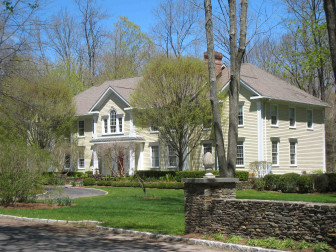The town is denying Silver Hill Hospital’s claims that it acted “arbitrarily” and “illegally” in turning down the psychiatric facility’s applications, filed in 2013, to use a private home contiguous to its campus for a residential program.

225 Valley Road. Credit: Office of the Assessor
Silver Hill the prior year had purchased the 1998-built Colonial at 225 Valley Road for $2.5 million, tax records show, and applied to the Planning & Zoning Commission for site plan and special permit approval in order to renovate and use it as a residential medical treatment facility.
Following well-attended public hearings at which several neighbors spoke out against the project, P&Z in November 2013 denied the application by a 6-3 vote. Three weeks later, the hospital filed a lawsuit claiming P&Z bent to the will of a biased commissioner, failed to stay neutral and “considered evidence submitted by opponents to the application after the close of the public hearing.”
“The nature of the process and conduct of the hearing by those Commission members voting for denial of the Application constituted a patently unfair proceeding in violation of the Plaintiff’s due process rights,” according to Silver Hill’s complaint (reproduced in full as a PDF at the bottom of this article).
The town in a terse answer filed April 8 denied Silver Hill’s allegations. P&Z on Tuesday is scheduled to discuss the case with Town Attorney Ira Bloom during an executive session prior to a regular meeting.
Bloom could not immediately be reached for comment. Silver Hill officials declined to comment on the active litigation when reached by NewCanaanite.com. It isn’t clear why P&Z is discussing the matter now. Under an order issued Thursday in state Superior Court in Stamford, the case will be assigned an administrative appeals hearing date later this year.
A review of Silver Hill’s applications and public hearing minutes—meetings that stretched over a six-month spam in 2013—reveals deep divisions between the hospital and many of its neighbors, as well as opposing points of view on P&Z on the contentious matter of institutional uses in residential zones.
Silver Hill had been seeking a special permit to renovate and use the dwelling at 225 Valley Road—which is on the east side of the street, opposite the hospital’s main campus—for a new, medical use (see page 45 of the Zoning Regulations here), and as well as approval for a site plan application (page 155 of the regs). Specifically, plans called for the dwelling to house eight patients—with a study to be converted into a bedroom and three garage bays into two more bedrooms and a sitting room.
P&Z Commissioner Kent Turner—who lives directly north of 225 Valley Road—recused himself during the public meetings, testifying at an initial hearing in May 2013 that “he is working out a mitigation plan with the applicant,” the minutes from that meeting say.
An agreeable plan seems never to have materialized, as area residents and professionals that they retained during hearings in July and August expressed concerns about messy conditions at other Silver Hill building sites, environmental impacts of the proposed project, future traffic and noise, intensity of the new use, shortcomings in the hospital’s applications and “uncertainty and anxiety” over not knowing its future plans.
One resident “expressed concern about people in crisis mistaking private homes in proximity to the hospital for part of the hospital,” according to meeting minutes, while another estimated “that having the hospital as an immediate neighbor has decreased his property value by 10 to 15 percent.” (An appraiser retained by the hospital disputed this point, saying the change in use of 225 Valley Road would have “no measureable impact” on property values, the minutes say.)
By August, 20 families had formed a neighborhood association that cited times the hospital fell short of being a good neighbor, and several called for the creation of a “master plan” by Silver Hill.
P&Z at its Nov. 6 meeting denied the application, with several of those opposed saying that the proposed development was not in harmony with the neighbors and would hinder those people’s use and enjoyment of their properties.
In its lawsuit appealing P&Z’s denial, Silver Hill claims that the commission “acted arbitrarily, illegally and in abuse of the discretion vested in it” by bending to the will of a biased commissioner, failing to stay neutral basing its decision “on various arguments and findings which are irrelevant or improper.”
“The Commission’s decision unreasonably restricts the Plaintiff’s use of its property and arbitrarily reduces the value of that property,” the lawsuit says.
A formal answer from the town filed April 8—nearly 18 months after the lawsuit itself had been filed—denies that Silver Hill met the required criteria to obtain a special permit (see page 162). Part of those criteria under “suitable location for use” reads: “The location and size of the site, the nature and intensity of the operations involved in or conducted in connection with the use, and the location of the site with respect to streets giving access to it are such that the use shall be in harmony with the appropriate and orderly development in the district in which it is located and shall promote the welfare of the Town.”
The Plan of Conservation & Development, a guiding document that was updated last year, under a section called “Protect Residential Neighborhoods” (see page 56), specifies: “As part of any application for establishment of such uses (or expansion of existing uses), the Planning and Zoning Commission should seek to minimize and/or manage the encroachment or impact of institutional and other uses currently allowed in residential zones on neighboring residential properties (noise, lighting, traffic, drainage, etc.). The Commission (and the neighborhoods) might benefit from a different approach where there are better tools in the regulatory toolbox.”
Specifically, the POCD calls for the town to consider introducing more specific, rigorous criteria for Special Permits.
https://newcanaanite.com/wp-content/uploads/2015/07/Silver-Hill-November-2013-complaint.pdf